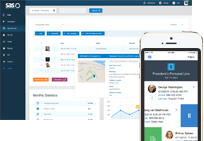- Log In
- Support
- Company
- Contact Us
- Live answers @ 1-888-532-4794
5 Tips on Call Forwarding with an Answering Service

If you use an answering service, then you’re probably familiar with call forwarding and how it works. However, if you’ve never used one before or are new to outsourcing – surprise – you’re going to need to know how to call forward. Since call forwarding is essential to using an answering service, we created a guide to help you understand what is call forwarding, as well as some tips on how to use it successfully with your service.
What is Call Forwarding?
Call forwarding is a standard phone feature that allows a person or company to direct their calls to another number. For example, if a company was in a meeting and couldn’t answer the phone, they could forward their number to an answering service who would field calls for them until they were ready to handle them again.
There are 3 basic types of call forwarding: All Calls Forwarding, No Answer Forwarding, and Busy Forwarding – but the way in which you are able to forward really depends on your phone provider. Some phone providers allow you to set scheduled times in which your phone can forward automatically, some you have to manually forward, and some only offer specific types of forwarding, like all calls, conditional, busy, etc.
All Calls Call Forwarding
All Calls call forwarding is the most popular type of forwarding. Like it’s name suggests, when All Calls call forwarding is set up, all of your calls will route to the number you’ve chosen without ever ringing on your phone first. For example, a business usually forwards all of their calls to their answering service after hours when no one is in the office.
No Answer/Conditional Call Forwarding
Conditional Call Forwarding gives you a chance to answer your phone first before it forwards to another number. For example, an incoming call may ring on your office phone 3 or 4 times before being routed to another number. With conditional call forwarding set up, you still have the chance to answer the call yourself, and if you can’t, your callers won’t be routed to your voicemail as they will be routed to another number of your choosing. This other number could go to someone else in your office, a cell phone, an answering service, or really wherever you choose to send it! Some phone providers allow you to set the amount of rings or seconds before the call gets forwarded as well.
Busy Call Forwarding
Busy Call Forwarding is a type of call forwarding that will route your calls to another number in the event your phone line is ringing busy. For example, if you are already on the phone, any other incoming call will route directly to another number instead of hearing a busy signal.
If your phone has multiple lines or if you have a feature like call waiting set up, your busy call forwarding setting may differ. Since forwarding varies depending on your provider, you would need to contact them to see how those scenarios would affect your forwarding.
5 Tips on Call Forwarding with an Answering Service
If you’re using an answering service, there are a few ways you can route calls accordingly. Whether you are forwarding your calls or having your customers dial the number directly, you should follow these 5 tips to make sure the transition from your business to your answering service is as smooth as butter.
#1. Talk to Your Phone Provider
Before you start using an answering service, check with your phone provider to make sure they are able to forward calls. While most providers do offer the forwarding feature, some providers have a more complicated procedure that may take up longer than what you had originally expected. For example, to forward your line under most phone providers you would dial *72 followed by the number you wish to forward to and it’s done. However, there are some providers that have to forward the line for you, and it may not be as quick and easy. So, before you start using a service make sure you know exactly how your forwarding feature works so that you don’t waste any time. For people using an answering service’s free trial, you could waste valuable time if you can’t get your forwarding set up quickly.
#2. Know the Different Types of Forwarding Available to you
Make sure you become familiar with all of the types of forwarding your phone provider offers, and set up a game plan for how you want your calls to be forwarded. For example, do you want to set up a schedule where your calls automatically forward between certain times, or do you want to manually forward them just when you get busy? If you’re manually forwarding them, do you want to have the option of answering before your service or do you want your service to just handle all of the calls? Becoming familiar with your options before using an answering service is another great way to ensure you’re not wasting time and money.
#3. Don’t have Call Forwarding? No worries!
While forwarding is the preferred method when working with an answering service, it’s not the end of the world if your phone provider doesn’t offer it. Some other options include:
- Google Voice: If you’re dead set on forwarding your lines but your phone provider doesn’t offer it, another option would be to use Google Voice. While this would require you to get a new phone number, Google Voice is a service that won’t put a dent in your wallet (because it’s free!) However, there are some connectivity issues that come along with using Google Voice.
- Advertise the Number: If you are unable to forward your line, advertising the number your answering service gives you is an option, albeit not always a good one. In most cases, you cannot take the number with you if you decide to leave service, so you may want to advertise sparingly. For example, posting the number on your social platforms and on your answering machine is easy enough to update, but printing the number on your business cards would be a nightmare to change.
#4. Make Test Calls
Once you’ve forwarded your line, test the line just to make sure it was connected successfully. If you’re not sure what you should be listening for, you can always call the number you’re forwarding to first. For example, if you’re forwarding to Specialty Answering Service, you would typically hear a custom greeting that would play prior to an operator getting on the phone. These greetings usually say something like: “Thank you for calling ABC Plumbing, we will be with you in a moment. For quality assurance this call may be recorded.”
#5. Know your Forwarding Number
Make sure you’re familiar with the number you are forwarding to. When using an answering service, they will provide you with a phone number unique to your business. Do not lose this number! Write it down, tape it to your computer, email it to all of your staff so everyone in the office knows what the number is and how to forward in case you aren’t able to do it.
What Happens if My Line Comes off of Call Forwarding?
Occasionally, you may see that your line has come off of call forwarding. This can happen for a number of different reasons, like if you happen to lose power or if your phone has been disconnected. If your phones are forwarded all the time, it may be good to test the line every now and then to make sure calls are still being routed appropriately. Scheduling recurring tasks on your calendar is a great and easy way to remind yourself to test your line every couple of weeks or so.
If your line ever does come off of call forwarding and you are not around to re-forward them yourself, you can try contacting your phone provider who should be able to forward the line for you remotely. However, it’s important that you know your forwarding number like the back of your hand so you don’t accidentally give your provider the wrong number to send calls to. Yikes!
Categories
- Advice (32)
- Answering Service 101 (18)
- Best Practices (10)
- Call Center Jobs (6)
- Call Center Software (20)
- Comparison (2)
- Customer Service (30)
- Funny (31)
- Holidays (19)
- Industry Hacks (19)
- Infographics (53)
- International (1)
- Medical (8)
- News (12)
- Phone Etiquette (2)
- Phones (14)
- Pricing (8)
- Quizzes (3)
- Receptionist (11)
- SAS Products (29)
- Scripting (4)
- Services (5)
- Small Business (25)
- Starting Up (7)
- Tips and Tricks (19)
- Uncategorized (1)
- Videos (19)
- Workplace (6)
Recently writen
- Call Center Script Best Practices: Advanced Script Block Tips to Optimize Your Answering Service
- January 2025 Release Notes – Adjustments to Call Details Timeline, New Scripting Updates, Live Transcription, and more!
- April 2024 Release Notes – Voicemail Greetings, Ability to Access Websites With a Username and Password, and more!
- March 2024 Release Notes – New Add-On, Settings Revamp, and more!
Follow Us
How about a demo?
We'll show you how our web portal works and answer any questions you have about SAS.
Schedule a demo







